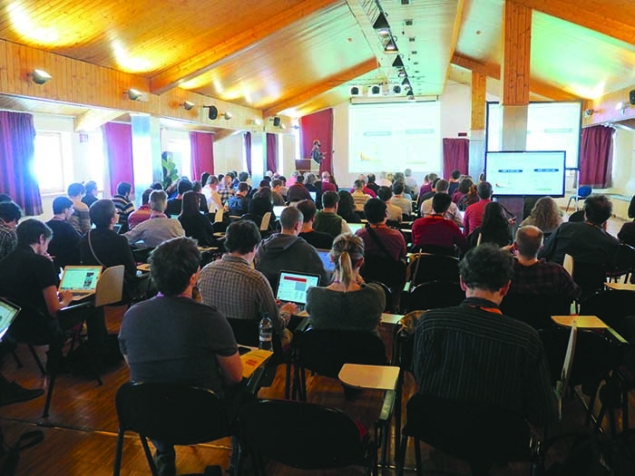The 2018 Moriond sessions took place in La Thuile, Italy, from 10 to 24 March. The annual conference is an opportunity to review the progress taking place over the breadth of particle physics, from B physics to gravitational waves and from advances in electroweak precision tests to exploratory searches for dark matter. The quest for new particles covers an impressive 40 orders of magnitude, from the 10–22 eV region explored via neutron-spin precession to the 13 TeV energy of the LHC and the highest-energy phenomena in cosmic rays.

Anomalies in the decays of beauty quarks found by the LHCb and B-factory experiments continue to entice theorists to look for explanations for these possible hints of lepton non-universalities, and experimental updates are eagerly awaited (CERN Courier April 2018 p23). Progress continues in the field of CP violation in B and D mesons, while quantitative tests of the CKM matrix are being helped by precise calculations in lattice QCD. Progress on leptonic and semi-leptonic D-meson decays was reported from BES-III, while Belle showed hints of the decay B+ → μ+ ν and evidence of isospin violation. In the classic field of rare kaon decays, the CERN SPS experiment NA62 showed its first results, presenting one candidate event for the elusive decay K+ → π+ ν ν– obtained using a novel in-flight technique.
Fundamental parameters of the Standard Model (SM), such as the masses of the top quark and W boson, are being measured with increasing precision. The SM is in very good shape, apart from the long-standing exception of forward–backward asymmetries. These asymmetries are also being studied at the LHC, and precise results continue to be produced at the Tevatron.
Results on top-quark production and properties are constantly being improved, while hadron spectroscopy is as lively as ever, both in the light meson sector (BESIII) and in heavy quarks (BaBar, Belle and LHCb). Data from HERA are still providing new inputs into structure functions, with c and b quarks now being included. Heavy-ion collisions at LHC and RHIC continue to explore the behaviour of the hot, dense quark–gluon plasma, while proton–ion collisions at fixed-target experiments (LHCb) provide useful inputs to constrain Monte Carlo event generators.
The news on the Brout–Englert–Higgs mechanism is good, with progress on many fronts. The amount of new results presented by ATLAS and CMS, including evidence of ttH production, and global combinations of production and decay channels shows that the precision on the couplings between the Higgs and other particles is improving fast. The study of rare decays of the Higgs boson is advancing rapidly, with the H → μ+μ–decay within reach.
The search for heavy resonances is continuing at full speed, with CMS presenting one Z´ analysis employing the full, available LHC data set (77.3 fb–1), including 2017 data. Is supersymmetry hiding somewhere? Several analyses at ATLAS and CMS are now being recast to include more elusive signatures with various amounts of R-parity violation and degenerate spectra, and there is an emerging interest in performing searches beyond narrow-width approximations.
The search for dark matter is on, with WIMP direct searches maturing rapidly (XENON1T) and including novel experiments like DARKSIDE which, with just 20 l of very pure liquid argon, presented a new best limit at low masses. This field shows that, with ingenuity, there is still room to have an impact. Bounds on extremely light axion-like particles were presented by ADMX for QCD axions, and for neutron electric dipole moments. The interplay between these dedicated experiments and the search for directly produced dark matter at the LHC are highly complementary.
The field of neutrinos continues to offer steady progress with new and old puzzles being addressed. The latest results from T2K disfavour CP-conservation at the level of two sigma, while NOvA disfavours the inverted hierarchy at a similar level. A revival of decay-at-rest techniques and the measurement of coherent elastic neutrino–nucleus scattering by COHERENT (CERN Courier October 2017 p8) were noticeable. The search for heavy neutral leptons is taking place at both fixed-target and collider experiments, while reactor experiments (like DAYA BAY and STEREO) are meant to clarify the reactor antineutrino anomaly. The puzzle of sterile neutrinos is not yet completely clarified after 20 years. Deep-sea (ANTARES) and South Pole (IceCube) experiments are now mature, with ANTARES showing, among other things, searches for point-like sources. IceCube presented a brand new analysis looking for tau-neutrino appearance that is competitive with existing results. Neutrinoless double-beta decay experiments are now biting into the sensitivity of the inverted mass hierarchy (CUORE and EXO-200), with promising developments in the pipeline (CUPID).
Completing the programme of the electroweak session was a glimpse into the physics of cosmic rays and gravitation. The sensitivity of AUGER is now such that mapping the origin of the cosmic rays on the sky becomes feasible. With the observation of a binary neutron-star collapse by LIGO and VIRGO, 2017 saw the birth of multi-messenger astronomy.
On the theory side, one continues to learn from the abundance of experimental results, and there is still so much to be learned by the study of the Higgs and further high-energy exploration. SM computations are breaking records in terms of the numbers of loops and legs involved. Electroweak and flavour physics can indicate the way to new physics scales and extend the motivation to search for dark matter at very low energies. The case to study neutrinos remains as compelling as ever, with many outstanding questions still waiting for answers.
• Augusto Ceccucci, CERN.





